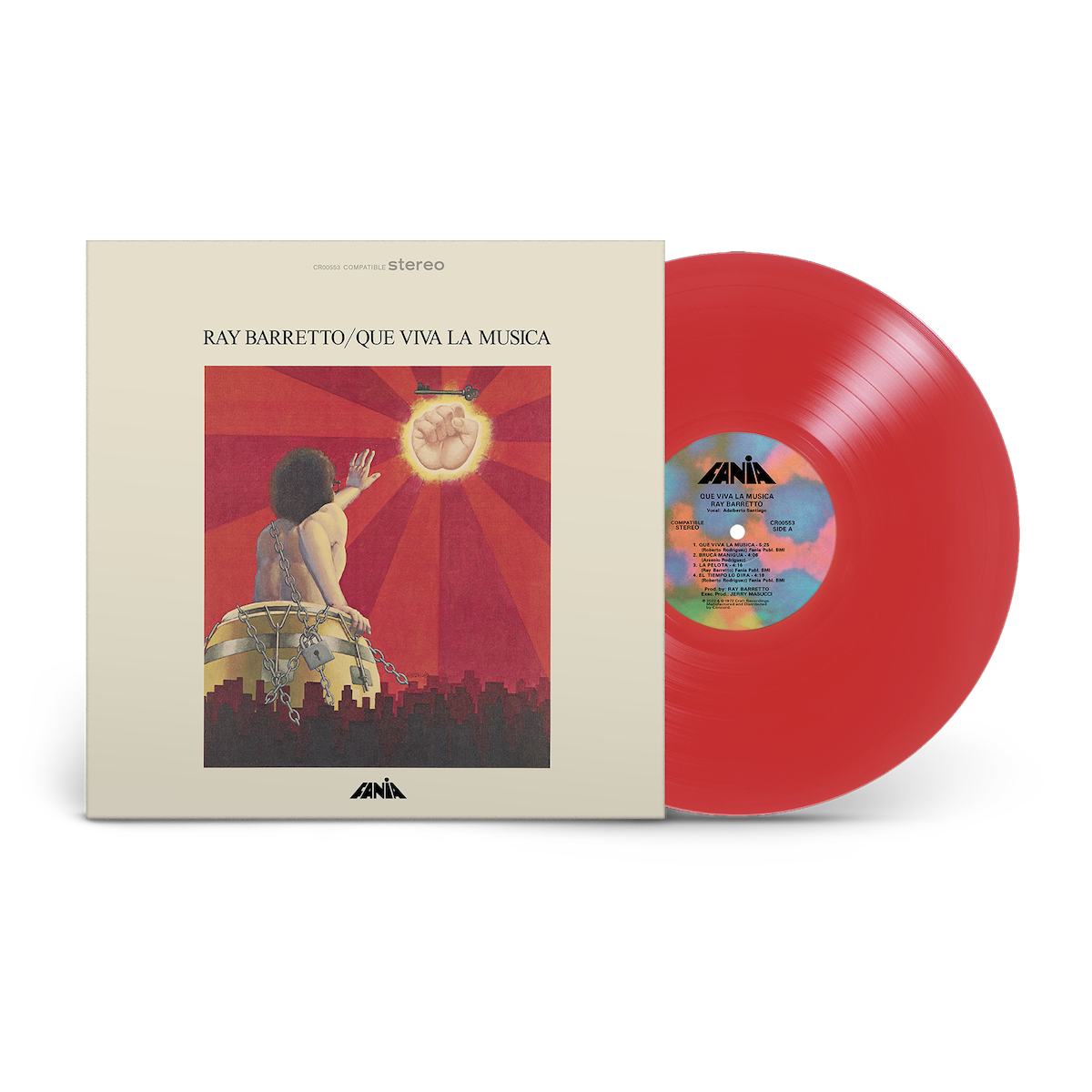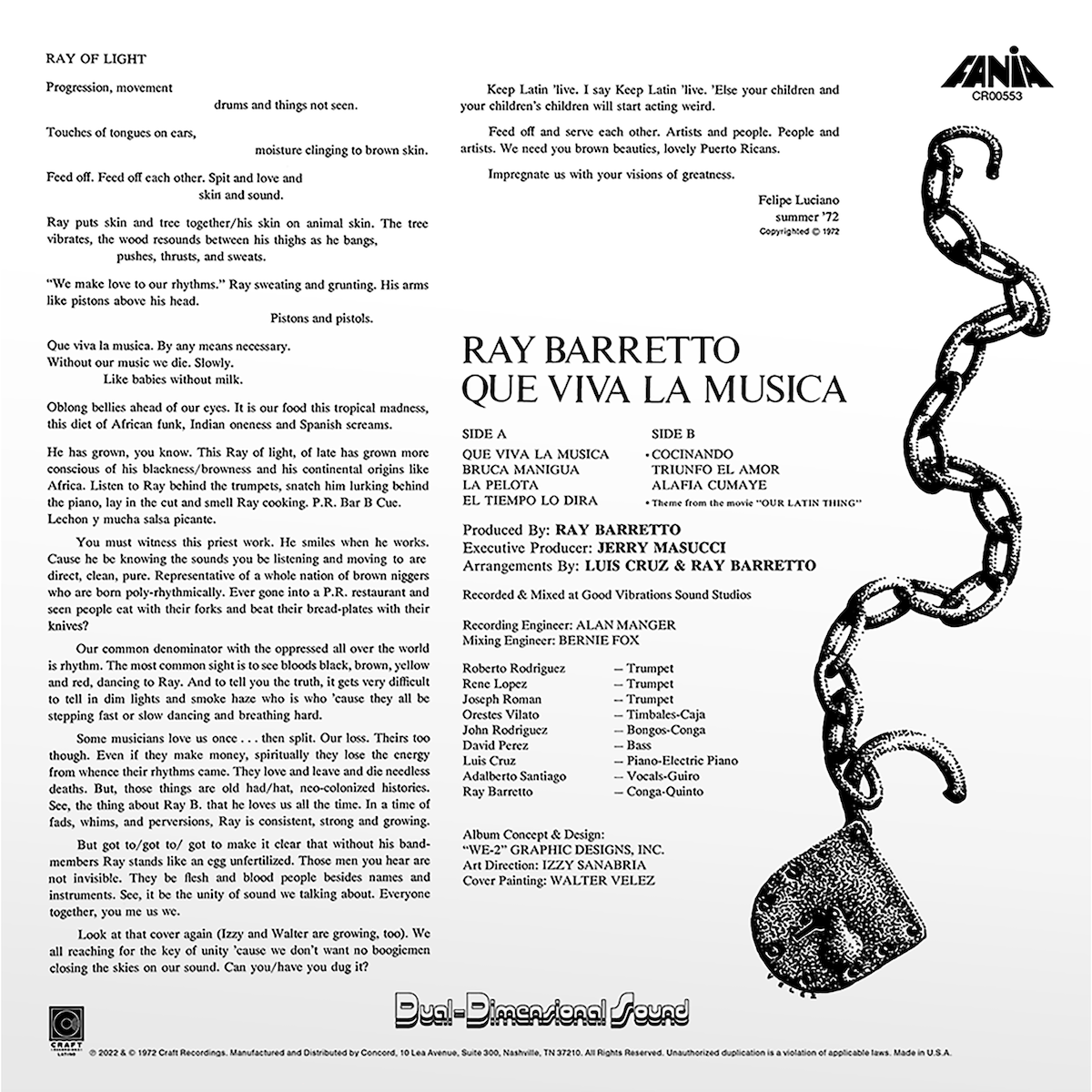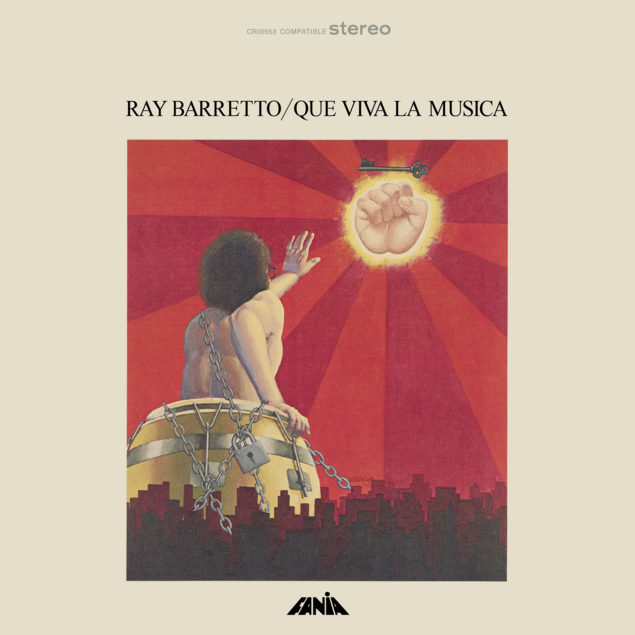Ray Barretto’s "Que Viva La Música" Returns to Vinyl
an AAA package of a classic release from the legendary conguero
You’ve never seen a cleaner Cadillac in your life. My 1985 Eldorado was triple black and it proudly boasted the “Biarritz” package which upgraded it with a stainless steel roof and extra plush leather seats. Even though it was over a decade old by the time I took ownership of the vehicle, you wouldn’t know it because of how carefully I cleaned and detailed it almost each and every weekend.
In the summer evenings, with the Eldorado in showroom condition, a buddy or two of mine would take it for a spin, usually through downtown Paterson, NJ. One of the car’s weak points (aside from the sluggish acceleration) was its stereo system. Instead of an in-dash CD player there was only a lowly cassette deck. Aside from that, however, there was always the good old radio. On a Saturday evening, nothing was more fitting than switching on Vicki Sola’s WFDU 89.1 FM radio program, Que Viva la Música, the NYC region’s go-to source for classic salsa and Latin music. While I wasn’t a particular aficionado of Latin music, nothing else on the dial fit those summer evening drives to nowhere through the state’s third-largest city the way salsa did. Sola’s program always began with the song from which the radio show adopted its name: the title track from Ray Barretto’s 1972 album, Que Viva la Música (Long Live the Music).
By complete coincidence, some years later, I joined the staff of WFDU, 89.1 as an undergraduate student on the Teaneck/Hackensack, NJ campus of Fairleigh Dickinson University (by this point, I was sporting a different Cadillac: a 1993 Seville). Of course, Sola’s program was still on the air and I enjoyed hearing that theme song each Saturday night as I proudly listened to my station’s broadcasts. It’s possible that few people on Earth have heard Ray Barretto’s version of “Que Viva la Música” more than I have. So, before I put the needle on the recent Fania/Craft Recordings 50th anniversary reissue of the album, I may have rolled my eyes just a bit. Of course, I was curious to hear this new release, but what could this listening session offer that I hadn’t already heard?
What I listened to was surprisingly revealing: bongos and percussion snapped into focus, vocal detail was undeniable and the power and strength of the studio musicians was palpable. Even better, while the new pressing was more analytical, it didn’t lose any of the dusky downtown, summertime magic that I was used to hearing on the FM airwaves. I could easily imagine rolling down the Eldorado’s windows so that those on the street could hear the party that was happening inside the Caddy.
 Born in Brooklyn and raised in the Bronx, Ray Barretto employed his Puerto Rican heritage and upbringing to become one of the genre’s leading musicians in a variety of Latin musical styles including Latin Jazz, famously appearing on albums by Dizzy Gillespie, Cal Tjader, Kenny Burrell, and Wes Montgomery. With 1962’s “El Watusi” Barretto made a name for himself and built a career that brought him to the apex of the Latin music community and beyond, bringing his conguero skills to the recordings of The Rolling Stones and the Bee Gees. Barretto’s albums on the Fania label - like 1968’s pinnacle of boogaloo, Acid, and 1970’s Barretto Power - are highly collectible and well regarded for their fusion of Latin styles with funk and psychedelia, each album creating an irresistible musical mosaic reflecting the sounds of the New York City metro area’s streets that Barretto inhabited. Ray received many honors during the last stage of his career, even winning a Grammy in 1990.
Born in Brooklyn and raised in the Bronx, Ray Barretto employed his Puerto Rican heritage and upbringing to become one of the genre’s leading musicians in a variety of Latin musical styles including Latin Jazz, famously appearing on albums by Dizzy Gillespie, Cal Tjader, Kenny Burrell, and Wes Montgomery. With 1962’s “El Watusi” Barretto made a name for himself and built a career that brought him to the apex of the Latin music community and beyond, bringing his conguero skills to the recordings of The Rolling Stones and the Bee Gees. Barretto’s albums on the Fania label - like 1968’s pinnacle of boogaloo, Acid, and 1970’s Barretto Power - are highly collectible and well regarded for their fusion of Latin styles with funk and psychedelia, each album creating an irresistible musical mosaic reflecting the sounds of the New York City metro area’s streets that Barretto inhabited. Ray received many honors during the last stage of his career, even winning a Grammy in 1990.
Que Viva la Música is a relatively short album, clocking in at 36 minutes (consider also that one of the tracks is 10 minutes long). The aforementioned title track begins with an exciting fanfare that introduces the listener to the complex rhythms on display throughout the record provided by the throbbing powerhouse of Barretto on congas, John Rodriquez on bongos and congas, and Orestes Vilató on timbales and percussion. Well-defined and powerful vocals lift the auditory blanket off of more than two decades of my listening to the song. The recording studio was busy with performers, but this current rendering finds a place for everyone who was on the session; no one steps on anyone else’s toes.
The really enjoyable reverb decay on the musical breaks in “Bruca Maniguá” leaves plenty of air and space; one can almost reach out and touch those reverb trails. The listener’s brain becomes busy chasing the featured musician on “La Pelota”! Are we following the vocals, the trumpet blasts, or the percussion? Like a dizzying backyard party, Trying to keep up and “watch” the soundstage on this track is like being at a dizzying backstage party, exhaustingly fun and exciting; goosebump territory. “La Pelota” (“The Ball”) feels as if one is keeping both eyes on a ball being quickly tossed between two people. When the vocals take center stage, as they do on “El Tiempo lo Dirá,” they run the risk of being overtaken by the percussion and horns surrounding them, but ultimately the mix - and this remaster - are sturdy enough to withstand the challenge and present a satisfying conclusion to side one of the album.
Side two's opener, the epic "Cocinando", adds funky keyboard parts to the percussion that's proudly on display here, and, of course, on the entire album—not just percussion as a concept, but as a detailed sonic picture of what the instruments might actually look like—the tactile minutiae that is present on this recording offers a glimpse of the drum skins' texture, the gleam of the drum rims, even envisioning the well-worn hands that make contact with the instruments. Of all the album's tracks “Cocinando” most thoroughly explores the backline of Barretto’s excellent band.
“Triunfó el Amor” provides a well-deserved respite from all of the excitement by taking things down a considerable notch, or maybe two, to focus on Adalberto Santiago's velvety lead vocal. The album’s closer “Alafia Cumaye” again displays the percussive prowess of Barretto’s team with the last 30 seconds of the album in particular providing a rousing ending to an animated and exhilarating album.
 Originally cut at Sterling Sound by Lee Hulko, this new, 180-gram pressing, mastered and cut directly from the original master tapes by Kevin Gray at Cohearent Audio includes a nicely produced "Tip-on" jacket featuring a crisp reprint of Izzy Sanabria’s thoughtfully complex cover art direction featuring a Walter Velez illustration. Sanabria was the art director for many fabulous Fania album covers. The pressing is available in either black (my copy) or “ruby” red. For those inclined, the album is also available - for the first time - in 96/24 and 192/24 hi-res audio. Discogs shows that the last vinyl pressing was a 1975 reissue. My copy was extremely flat, centered, and extraordinarily quiet.
Originally cut at Sterling Sound by Lee Hulko, this new, 180-gram pressing, mastered and cut directly from the original master tapes by Kevin Gray at Cohearent Audio includes a nicely produced "Tip-on" jacket featuring a crisp reprint of Izzy Sanabria’s thoughtfully complex cover art direction featuring a Walter Velez illustration. Sanabria was the art director for many fabulous Fania album covers. The pressing is available in either black (my copy) or “ruby” red. For those inclined, the album is also available - for the first time - in 96/24 and 192/24 hi-res audio. Discogs shows that the last vinyl pressing was a 1975 reissue. My copy was extremely flat, centered, and extraordinarily quiet.
Ray Barretto passed away on Friday, February 17, 2006 at the Hackensack University Hospital. My imagination makes me wonder if a few hours later—on the following Saturday night—there might have been a hospital radio tuned to WFDU, 89.1; if so, there’s no doubt that Barretto’s ode to the timelessness of music—no matter the genre—may have floated out of a small office or reception area and down a hallway searching to connect with the sounds of a city on a weeknight in New Jersey. The Que Viva la Música program has now moved to a different time and evening. But, the next time the weather is right, you might take an aimless, windows open Saturday evening drive and listen to the high-res stream of Barretto’s, “Que Viva La Musica”. Be prepared for the people on the street you pass by ask what you’re listening to; they’ll want to go to the party, too.











































